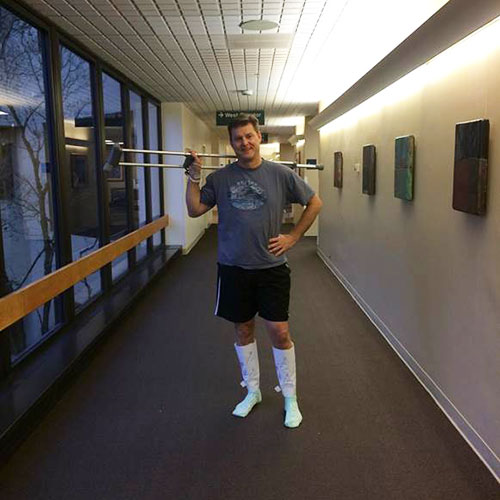Anterior Hip Replacement

One of the most common questions I get in my practice regards the advertised magic of an anterior hip replacement. Patients are being told by both surgeons and orthopedic implant companies that this approach offers something unique and different compared to other approaches. Unfortunately, this is a flatly untrue, unscientifically supported myth that exists for the purposes of marketing and currently misleads many well-meaning patients trying to pursue treatment for their hip arthritis.
Performing hip replacement requires what is called an “approach to the hip”. This is essentially a prescribed pathway to gain access to the joint to then allow the surgeon to perform the replacement surgery. Over time, several different pathways or approaches to the hip have been developed to allow surgeons a predictable route into that joint. The most commonly used approaches over time have been the posterior, anterior, anterior/lateral, and direct lateral. Since the advent of the modern era of hip replacement surgery each of these approaches have been used as the entry into the hip joint for hip replacement. Each, over time has had a different history of success, challenges and potential pit falls.
The most common approach over time has been what is called the posterior approach. It is the work horse approach of the bunch. It is used by the majority of surgeons for first time patient hip replacement. It is used almost exclusively in the setting of redoing or fixing problems with an existing replacement. The strength of this approach is in both its familiarity and its ability to be extended to address any potential problems that can come up during a replacement. Up to the early eighties, its main drawback was the rate of dislocation—when the ball of the replacement pops out of the socket. This is a very painful complication that requires a trip to the emergency department. During this time the risk was between 10-15%. In an attempt to address this, the industry adopted an idea called “hip dislocation precautions”. This limited patients in their post operative movements such as hip bend or flexion and turning the leg in. This change did nothing to reduce the incidence of dislocation but it made hip recovery much more difficult. None the less, it was adopted worldwide and accepted as gospel by all orthopedic surgeons. Then, in the late nineties, a surgeon discovered a technique change in how the posterior approach was performed that dramatically reduced the risk of dislocation to nearly zero. Despite this improvement which brought dislocation risk for the posterior approach to the same level of risk as that of all the other approaches, the stigma of dislocation stuck with the posterior approach.
The other approaches have their own unique problems. The anterior approach has a high risk of nerve problems with a nerve called the lateral femoral cutaneous nerve. This is a sensory nerve for the front of the thigh. Injury or damage to this nerves can cause anything from numbness to pain in that area. Incidence of this problem has been reported up to 15% for anterior approach hips. Many, but not all, of these nerve issues will resolve with time. Patients with this complication report it as being difficult to deal with. The anterior approach, in the late nineties gained some popularity because it had a much lower risk of dislocation than the posterior approach—that is prior to the technique change I mentioned above. That perceived benefit of lower risk of dislocation persists today although the benefit is not real—both approaches carry very similar and very low risk of dislocation.
In the early 2000's, many surgeons around the country began exploring the idea of performing hip replacement surgery through very small incisions. Hence was born the idea of minimally invasive hip replacement surgery. Most of these surgeons used the posterior approach for this technique, some used the anterior approach. With this idea came the realization that hip replacement patients no longer needed to stay in the hospital for the traditional length of time of 7 to 10 days. Soon patients were leaving the hospital in 3 days. This was a massive paradigm shift for the orthopedic industry and was a welcome change for everyone. Subtle debate began in our industry as to which of these approaches—the limited posterior or the direct anterior—were better at achieving the goal of early hospital discharge. Over time, that idea has been debated and studied openly in the orthopedic industry.
Today, we are able to discharge most patients from the hospital the day after surgery. Some patients require more time, but it is becoming more the exception than the rule. Two years ago we began performing total hip replacement surgeries in ambulatory surgery centers, sending the patients home just several hours after surgery. In fact, I performed the first outpatient hip replacement in Oregon several years ago and have done many outpatient hip replacements since that time. Most importantly, I only perform my hip replacements through the posterior approach.
Learn more about Outpatient Joint Replacement with Dr. Ballard >
Many proponents of the anterior approach firmly state in advertising and marketing that the feat of outpatient hip replacement is only possible with an anterior approach. They argue that the anterior approach uniquely allows patients to recover quickly and get back readily to their regular lives. They further argue that it is the only approach that does not cut muscle. The reality is that the same statements are true of the posterior approach. In fact, as the debate has progressed about the anterior approach it has been firmly, scientifically concluded by surgeons worldwide that the anterior approach is not superior to any other approach in any way, at any time during the recovery period. Anterior hips do not leave the hospital sooner than posterior approach hips, they do not recover faster, limp less, or have less pain.
Recently, data has been emerging that in fact the opposite situation is proving true. Data shows an actual increase in complication rate for patients having their hip replaced through the anterior approach. This is not news to me. I have seen this over the course of my practice.
For these reasons, I use the posterior approach to replace hips. I could easily learn and apply the anterior approach for my patients, but I choose not to because it is not the right thing to do, in my hands, for them or for me.
